|
|
A mayor of Kerman, Iran
residing over the business of the city about sixty years ago, once
expressed to visitors from the capital his wish that the rest of the city
would follow the lead of the residents of Gabr-Mahalla[ii]
(Zarathushti quarters).
To the surprise look of
his visitors not expecting such a complement to be paid to a minority
group, the mayor went on to explain that the residents of the Gabr-Mahalla
on a regular basis clean inside their houses as well as broom the alley
and public passages outsides their houses. After brooming the alleys
outside their homes they regularly spray water (that they labor hard to
get) to keep the dust down (most city alleys and roads were not paved
yet), and in the morning they regularly burn good smelling scents over the
fire that helps keep the air nice smelling and fresh. The mayor who
could have been equally talking about the Gabre-Mahallas of Yazd or
villages around Yazd, went on to say. Compare that with the rest of the
city, where the residents treat the public walkways outside their homes as
their local garbage dump and show no regards for the environment.
[iii]
Kermanís Gabr-Mahalla in
its current locality became home to the surviving Zarathushtis of Kerman
some two centuries ago.
[iv] In time it became
very self sufficient with complete set of schools for boys and girls
(Kermanís first high-schools), a kindergarten, Fire temple and other
Zoroastrian religious centers, a sports facility, community halls, Medical
clinic, a hostel all provided through private donation of the residents of
the Gabr-Mahalla whose pride of ownership made it a model neighborhood in
the city.
A unique feature of the
Gabr-Mahalla was the fortress like walls of each home, and the crocked and
narrow alleys snaking through much of the neighborhood - all designed to
provide maximum protection to its inhabitant. The tall walls would have
made it difficult for the ruffians and Moslem Zealots to scale and cause
harm to the vulnerable Zarathushtis who had no protection under the Qajars.
The narrow alleys served to make it difficult for the herds from rushing
the houses. Each house was built with condensed living quarters,
basements and secret places to store preserve-able food items for the
times of duress and during the winter months. There were also secret
passages between homes including joint roofs, through water canals to be
used as a last resort if a house fell to the ruffians and the inhabitants
had to run for their lives. Most houses had their own water well, and a
courtyard with trees, mostly fruit trees, but often a Cypress (evergreen)
tree.
The occasions that proved
most stressful for the inhabitants of Gabr-Mahalla included times of
national upheavals such as regicides, when there could be a total break
down of law and order at local levels, and the minorities would have been
the most vulnerable groups. Also during the Muslim Holy months of the
year, firebrand Islamic cleric speaking to Mosque crowds and inciting
violence against the Zarathushtis could have sent mindless followers
running in the direction of Gabr-Mahalla to inflict harm.
Although the Gabr-Mahalla
was predominantly inhabited by the Zarathushtis, there were few Moslems
inhabitants mostly converts to Islam residing in the homes inherited from
their parents. There were also some wealthy families belonging to minority
Moslem sects who preferred and felt safer setting up residents in the
company of Zarathushtis in the Gabr-Mahalla. The foreign consulates that
at one time operated in Kerman preferred the ambiance of Gabr-Mahalla. The
consulate of Czarist Russia as well the brief period the Ottomans operated
a consulate in Kerman had set up shop within the perimeter of the
Gabr-Mahalla or just on its boundary where the consulate staff would live
too.
The large consular complex
the British operated in Kerman, although not within the bounds of the
Gabr-Mahalla, was closer to the Gabr-Mahalla than the rest of the city and
was bordered by properties owned by Zarathushtis.
The few long terms foreign
residences of Kerman, including Greek merchants, a Bulgarian prince
(fleeing the communistsí take over of Bulgaria) also preferred the
Gabr-Mahalla. One of the survivors of Ottomanís Genocide of Armenians of
Anatolia who had fled Eastwards to Kerman, was also anchored to the
Gabr-Mahalla and had taken up residence just on the boundary of the
Gabr-Mahalla.
One of the oldest movie
houses of the city - set up by Zarathushtis - was also on the boundary of
the Gabr-Mahalla.
The security and
prosperity of the inhabitants of Gabr-Mahalla improved drastically after
1925 when the Qajars were ousted by the Parliament of Iran and the Pahlavi
dynasty was voted to replace them. From that point with the protection of
law being extended to all Iranians including minorities, and with major
improvements in the conditions of the nation, the Zarathushtis of the
Gabr-Mahalla started a gradual move to the upcoming national capital of
Tehran in realization of greater opportunities. The pace of departure
increased further following the 1979 Islamic revolution with many
Zarathushtis heading overseas. A small number of Zarathushtis remain
in the Gabr-Mahallah, and some have moved to more upcoming-affluent
Western neighborhoods of the city.
The improved conditions
the Pahlavi era afforded Iran and the Zarathushtis of Iran, also meant the
old protective housing structures were no longer needed, and new
architectures started to be introduced. The improvement the Iranian cities
saw in that period, also meant paved broad streets were introduced by the
city government into the Gabr-Mahalla to replace some of the narrow
alleys.
Some departing
Zarathushtis sold their parental homes. There was no shortage of willing
buyers interested to move in. Other departing Zarathushtis kept their
properties or rebuilt them and maintain them long distance. Another group
donated theirs to the Kerman Zartoshty Anjuman for use and upkeep, and yet
another good trend emerging is to convert the houses they grew in, into
student hostels to be donated to the Kerman Anjuman for the benefit of
Zartoshty students from other parts of Iran attending one of the many
universities set up in Kerman. One of the universities has its campus at
the stately home of a Zartoshty family on the boundary of the old
Gabr-Mahalla.
The only time during the
reign of the Pahlavi dynasty that the security of Gabr-Mahalla was
threatened by mobs, happened in August 1953 in the aftermath of the
political upheavals in Tehran fostered by prime minister Mossadegh (also
spelled Mosadeq, Mossadeq) that led to Shah Mohamed-Reza Pahlaviís
departure from Iran. Although much of the drama played out in the capital,
leftist mobs in Kerman inspired by Mossadekh attacked the house of a
Zartoshty family in the Gabr-Mahalla that had hosted a family wedding few
days earlier. The mobs stormed in to loot the house, broke the arm of the
lady of the house inflicting injury on her. Through the fast action of
some of the guests who slipped out, and called upon a Zartoshty military
leader for help, the damage done was limited. Although, the army was
staying in their barracks and had not received any orders to deploy, that
young Zartoshty officer, Arastu Khosrow Soroushian, who was very much
respected by his troops and colleagues, ordered the soldiers under his
command out of the barracks and towards the Gabr-Mahalla. Hearing about
the approach of the troops, the mob disbanded. The troop stayed and
provided protection to the Gabr-Mahalla. Law and order was restored once
the Shah returned a few days later.
The term Gabr was given a
new dimension in the Persian vocabulary by those who meant to demean the
adherents of ancient Iranian religion, something that was not of
Zarathushtisí choosing. Gabr-Mahalla on the other hand, a place of their
making, where they could control and despite their meager means, they
turned it into a prime location reflective of their rich heritage. Now the
legacy of the Gabr-Mahalla - that even includes a derogatory term - is
part of that proud heritage.
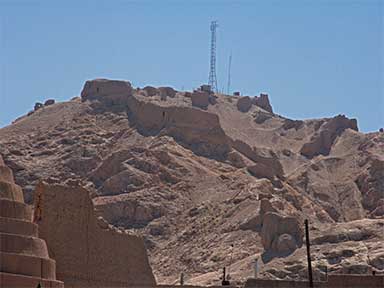 |
|
A view of the ancient mountainous
fortress named after Sassanian Shah Ardeshir overlooking the
Gabr-Mahalla from the South side. |
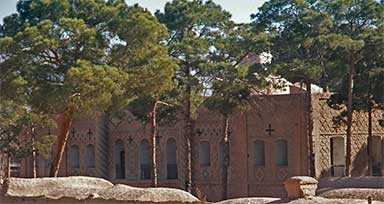 |
|
View of the rear of a Stately home of a
Zartoshty family defining the boundary of the Gabr-Mahalla, now
serving as a university campus. |
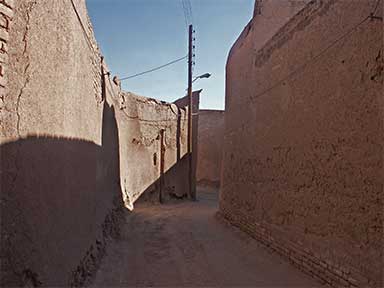 |
|
One of few remaining
old alleys of Gabr-Mahalla reminiscent of yesteryears. |
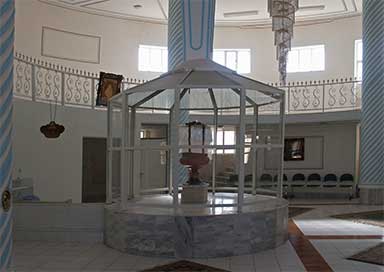 |
|
New Fire Temple of Gabr-Mahalla fueled
by Natural Gas |
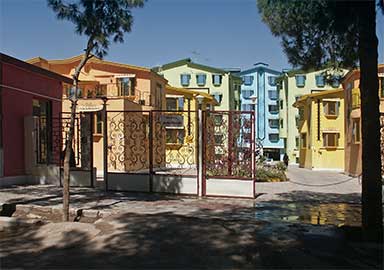 |
|
New housing complex
built on the premises in the Gabr-Malleh where once the Russian
Consulate in Kerman stood |
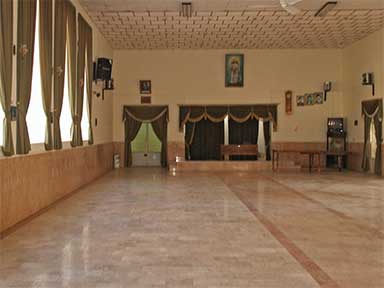 |
|
A Zartoshty community Hall in the
Gabr-Mahalla built with donation from Rustom Soroushian Kermani, a
byproduct of the Gabr-Mahalla, who moved to upstate New York in
early 20th century and became a successful businessman. |
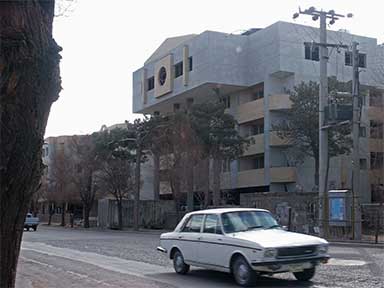 |
|
More and More the
New Face of Gabr-Mahalla |
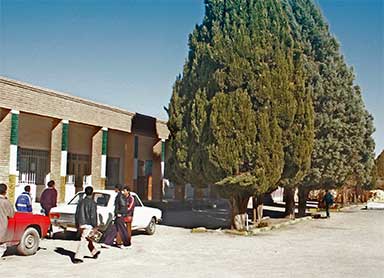 |
|
The Campus of
Iranshahr Zoroastrian Boys High School of Kerman, the first
high school in Kerman, that was run a community school by the
Zoroastrian Anjuman, now taken over by the government |
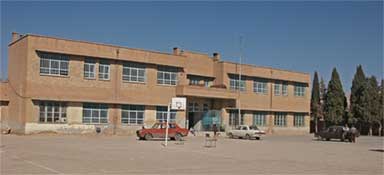 |
|
The Campus of Kaikhosrow Shahrokh
Zoroastrian Girls HighSchool of Kerman, amongst the first
high-school for girls in Kerman, that was run a community school by
the Zoroastrian Anjuman, now taken over by the government and used
an a high school for boys. |
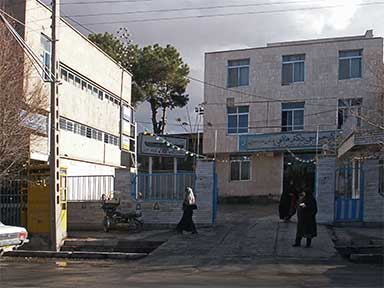 |
|
A Medical clinic in the Gabr-Mahalla
built on donation by Mr. Khodad Mehrabi, a businessman who grew up
in the Gabr-Mahalla and moved to London in the early part of the 20th
century. |
[i]
This visual essay was posted on October 24, 2004 based on photos taken
on site in Kerman in 2003 and 2004.
[ii]
The term Gabr, a derogatory term used by fanatical Moslem in Iran
implies adherents of the Zoroastrian religion. Mahella is a Farsi word
meaning neighborhood.
[iii]
The mayorís quote was reported by Emeritus professor of history
Mohamed Ibrahim Bastani Parizi of Tehran University in his book on
history of Kerman. He does not mention the mayorís name.
[iv]
For more information on Kermanís CaberMahella refer to the book,
City and Village in Kerman, Iran, by Professor Paul Edward
English, University of Wisconsin Press, 1966, pps. 45-49.
|